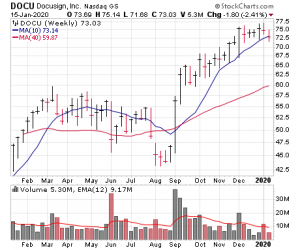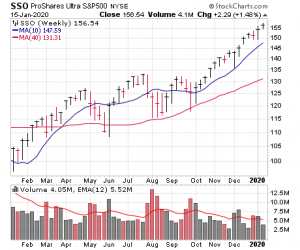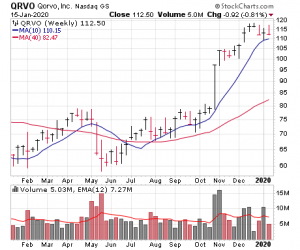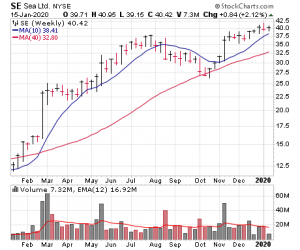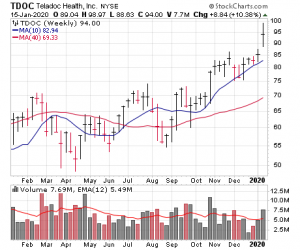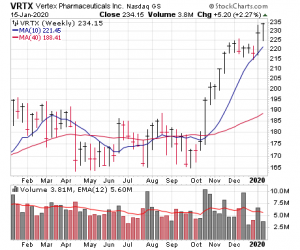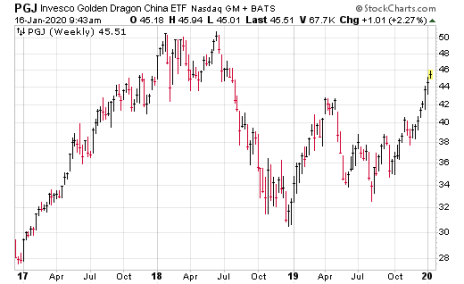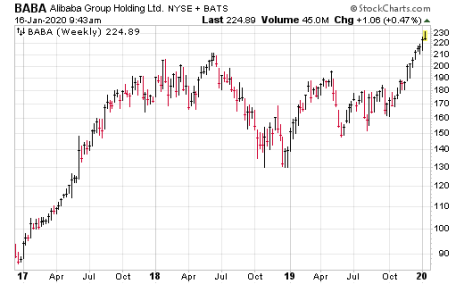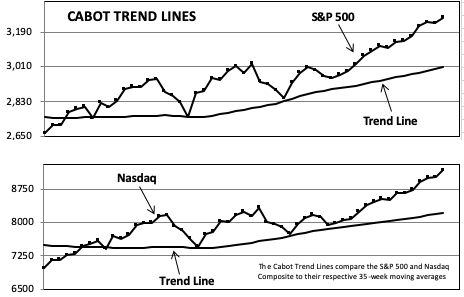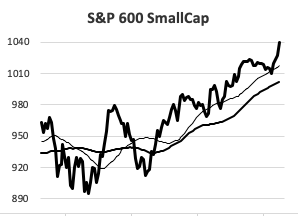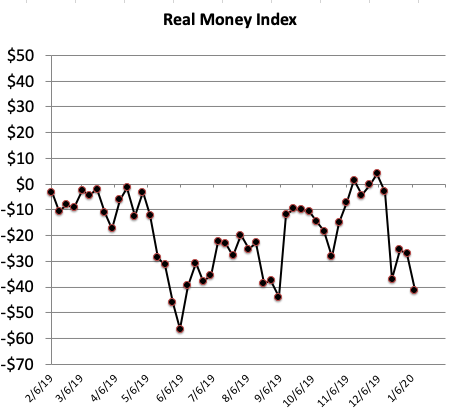The market remains super strong, and we’re pleased to see many growth stocks that rested during December break out to new highs so far this year. Shorter-term, the lack of good entry points among stocks we’re watching is a reason we’re still holding a chunk of cash on the sideline. But we remain very bullish longer-term and think pullbacks and/or shakeouts will provide some solid entry points.
Tonight, we’re standing pat once again with our collection of stocks, most of which act great. In the issue, we do write about one big-cap name that we think has regained its status as a liquid leader (Alibaba), and it’s probably the top stock on our watch list today. Elsewhere we do highlight some other ideas, and as always, share our latest thoughts on all the stocks we own.
Cabot Growth Investor 1437
[premium_html_toc post_id="195458"]
Just Because It’s Unusual Doesn’t Mean It’s Wrong
The year is just over two weeks old, but we’ve already been subject to the Iran attacks, a Phase 1 trade deal with China, and soon, an impeachment trial in the Senate. Accompanying those are countless opinion pieces of what each may portend (including plenty of skepticism regarding the China deal), and that doesn’t even get into the “normal” news flow (economic and earnings reports, etc.) that we’re treated to.
Despite all of it, the market has remained in a steep uptrend with pullbacks limited to a couple hours here and there. Individual stocks haven’t been as smooth but still look great, with a “rotational advance”underway, where some groups rest while others ramp for a couple of weeks, before they switch places. We’re pleased to see most of the growth stocks that took a breather during December push to new highs in 2020.
No question, it’s fair to classify the advance as unusual, in a good sense—you don’t see many straight-up rallies that go on for this long! But just because it’s unusual doesn’t mean it’s wrong. In fact, we think the vacuum of selling pressure is a good sign that this bull market has plenty more in store.
Part of the reason we say that is based on the charts—with the market and individual stocks showing this much power following very long launching pads (20 months for the S&P; tons of one- to three-year bases for growth stocks), it’s usually a kick-off, not a blow-off. Indeed, we were recently talking to a hedge fund friend of ours who agreed that there are a bunch of powerful, persistent and (because of their breakouts from those huge consolidations) early-stage charts that could easily go higher for many more months. That’s relatively rare to see.
But beyond the charts are market history. We ran a simple study this morning: For the first time in more than six months, the S&P has (a) risen at least 13% during the past 14-plus weeks, and (b) stands above its 200-day line. That’s only happened 20 other times since 1980, and the results of what happened afterwards back up our overall bullish view—six months later, the S&P was up an average of 8% (all but one instance was positive, in fact), while a year later, the median return was +14%. Not bad.
That’s not to say a pullback won’t come (40% of the time the market was lower a month later), especially with so many secondary measures still flashing yellow. But the odds strongly favor corrections proving buyable.
What to Do Now
Overall, then, you should remain mostly bullish, though we still favor stepping a bit lightly on the buy side. The good news is that any shakeout or tight trading area should offer up some solid opportunities. Tonight, though, we’ll again sit tight, riding our winners and holding onto a 17% cash position.
Model Portfolio Update
The market has been kiting higher for three and a half months at this point, but as is often the case, individual stocks haven’t all moved in lockstep—we’ve seen some mild internal rotation going on every couple of weeks, with some stocks motoring higher before resting, when others take the baton.
In December, for instance, many strong growth stocks actually rested in tight ranges, and we’re pleased to see many of them come to life. Meanwhile, stocks that ripped higher through December have begun to pull in. Given that the market is extended, it’s likely we’ll see more ups and downs ahead.
Overall, there’s no question it’s a bull market, and we’re holding on tightly to our winners. That said, finding decent-looking entry points for intermediate- to longer-term positions (our wheelhouse) isn’t easy, either. The good news is that any modest pullback could provide some opportunities, but tonight, we’ll again just ride with what we have and see what comes.
Current Recommendations
Dexcom (DXCM 234)—Dexcom was one of three Model Portfolio stocks (TDOC and VRTX were the others) that presented at this week’s JP Morgan healthcare conference, and as expected, it gave some key updates on business. First off, preliminary Q4 revenues of $457 million were up 35% from a year ago and easily ahead of estimates of $432 million, which confirms that G6 sales are going gangbusters. As for 2020, the firm guided in-line (sales growth of 19% or so), which is their m.o., usually guiding conservatively and then topping expectations down the road. Coming after a solid romp higher last week, the good-not-great guide caused the stock to pull in, but it found support in short order and is still hovering near virgin turf. Beyond the numbers, the firm talked up its G7 glucose monitor (limited release scheduled in the second half of this year), which has many advantages over the G6 (can be worn longer, it’s smaller, should sport lower pricing, etc.) and will dramatically boost Dexcom’s addressable market. We remain optimistic DXCM’s very long runway of growth will drive it higher going forward. Hold on if you own some, but if you don’t, we’re OK picking up shares around here. Earnings are likely out mid February. BUY.
DocuSign (DOCU 73)—DOCU has continued its positive, but not powerful, action during the past couple of weeks—shares are holding above their 50-day line (they tested the intermediate-term trend line earlier this week) and remain in an uptrend, though the stock hasn’t made progress since its earnings-induced pop in early December and it’s basically performed in line with the market during the past few months. As we’ve been writing, though, we’re putting more weight on the fact that (a) it’s hard to find a growth story that offers such rapid and reliable growth as DocuSign, and (b) the overwhelming September breakout from a 15-month launching pad should have longer-term bullish implications. Much more weakness from here would probably have us going to Hold, but given what we see today, you can pick up shares here. BUY.
Inphi (IPHI 82)—Following seven weeks of consolidation and a couple of tests of the 50-day line, IPHI broke out nicely last week on a solid pickup in volume, which is obviously good to see. The firm completed its acquisition of eSignal this week (for $216 million), which not only solidifies its leadership position in products that connect data centers, and importantly, is expected to be highly accretive to earnings in 2021 (boosting the bottom line by 20% on its own!). With many uncertainties out of the way that possibly could have crimped business spending, the odds are even greater that demand for Inphi’s high-speed interconnects will be in big demand for many quarters. Earnings will likely be released around the end of January. BUY.
ProShares Ultra S&P 500 Fund (SSO 159)—To pull back or not to pull back? That’s the question on every investor’s mind as the major indexes continue to levitate; the S&P 500 is now up nearly 16% (in less than 15 weeks) since its early-October low. Of course, at some point, there will be a pullback, and given the size of the advance, it’s likely to be more than just a two- or three-day event—the past two times the S&P roared out of a multi-month range (2013 and 2016), the initial pullback/correction was in the 4% to 7% range. That’s not a prediction at all (it’s hard to read into two instances), but we’re clearly extended to the upside and most (not all—see our talk about money flows later in this issue) secondary measures hint that some potholes could be upcoming. Thus, we don’t think there’s anything wrong with booking a little partial profit in SSO if you want; given our large position size, it’s something we may consider going forward. Right now, though, we’re keeping our eyes focused on the likelihood of higher prices down the road and putting more weight on the currently strong momentum. If you want in, we advise looking for some sort of shakeout to the rising 25-day line (currently at 151 and rising quickly). BUY.
Qorvo (QRVO 114)—Along with some semiconductor peers (including a couple focused on 5G smartphones), QRVO has been in a normal consolidation for three weeks (fallen just 8% from high to low; never got to its 50-day line). Chip stocks are frequently hard to handle, partially because they’re down-the-food-chain situations; if a big customer or two sneeze (usually because of industry conditions), then everyone gets the flu. That’s why our eyes are always open for a meaningful change in character, but right here, our thoughts haven’t changed: It’s likely that Qorvo will be one of the big beneficiaries of the 5G ramp in 2020, and the out-of-this-world November breakout should bode well going forward. We half-expect some more wobbles in the days ahead, but we’re sticking with our Buy rating, thinking this rest (and/or any coming shakeout) will prove buyable. As a heads up, the next quarterly report is due out in less than two weeks (January 29), so you might consider keeping new positions on the smaller side. BUY.
Sea Ltd. (SE 41)—Sea has mostly meandered since we nabbed a half-sized position in late December—not ideal, but not every stock is going to get going right away, so we’re content to give shares some room to maneuver. Overall, the stock is still sitting just above its multi-month range, and the recent dip toward the rising 25-day line (now above 39) looks buyable to us. Fundamentally, we’re intrigued by the firm’s recent application for a digital bank license in Singapore; the firm already offers e-wallet, micro-lending and payment processing services through its SeaMoney operation, and aims to offer an expanded suite of financial services to small- and mid-sized business in Southeast Asia. A move below the 36 to 37 area would tell us the recent breakout has failed (prodding us to cut the small loss), but we’re still OK starting a half-sized position here if you don’t own any. BUY A HALF.
Teladoc (TDOC 97)—TDOC boomed to new highs earlier this week on a couple of pieces of exciting news. First, the company announced the acquisition of InTouch Health for $600 million (likely to close in Q2) that should complement Teladoc’s current offerings beautifully—while Teladoc is mostly focused on providing virtual care services outside the hospital setting, InTouch is a leader in providing those within a hospital, making TDOC a single source provider of virtual care services that customers, providers and hospitals need. (InTouch had been growing at 35% rates, too.) More than that, the company raised its Q4 guidance by a few percent (revenues likely rose 27% or so), and the top brass released some other positive tidbits (it renewed its deal with Aetna, which should add to business in 2021; bookings were up 30% in recent months with larger average deal sizes; it’s pleased with how the United ramp is going). Bottom line, we think the story here is larger than ever, and the stock remains in great shape. We’ll stay on Buy, but given the stock’s normal volatility (and possible round-number resistance near 100), new buyers should aim for dips of a couple of points. Earnings are likely coming in mid to late February. BUY.
Vertex Pharmaceuticals (VRTX 236)—Vertex also presented at the JPMorgan healthcare conference, and while it didn’t make any major waves (it’s going to save 2020 guidance and Q4 results for its year-end report, which is likely out in early February), it did offer a few interesting numbers—management expects further label broadening for Trikafta (approval to treat patients 12-and-over in Europe this year; patients 6-11 years old in the U.S. after that; it’s addressable market should expand to 90% of all cystic fibrosis patients) and, longer-term, sees solid revenue and cash flow growth for many years to come, which is sure to keep big investors interested. The stock bounced off its 50-day line and moved to new highs last week, and it remains perched near virgin turf today. As with every stock, some further ups and downs are possible, especially if the market hits a pothole, but we think VRTX’s uptrend should carry it nicely higher over time. Earnings should be released in early February. BUY.
Watch List
- Alibaba (BABA 224): As we write later in this issue, we think Chinese stocks have come out of an 18-month funk and Alibaba appears to be a liquid leader once again. We like it on any weakness.
- Coupa Software (COUP 169): After hacking around wildly for months, COUP has lifted to new highs (though its RP line is still a bit shy of that). It’s not early in its overall run but the story remains excellent.
- Luckin Coffee (LK 49): Another Chinese name, Luckin is hot as a pistol thanks to its rapid growth story. Like some extended names, we’d like to see a cooling off period before jumping onboard.
- Tesla (TSLA 513): TSLA is a real leader of this advance, but we advise being patient here—it’s very likely a chunk of its recent gains are given back eventually. Any pullback to the 10-week line would be tempting.
Other Stocks of Interest
Zillow (Z 47)—We took Zillow on a test drive last year but nothing much came of it. But the underlying story didn’t change, and while the stock isn’t totally out of the woods, it has shown some intriguing persistency during the past three months. The company, of course, is the top dog in online real estate listings, and that’s still important; in Q3, its website and apps got a whopping 2.1 billion visits, up 11% from a year ago, which makes it a magnet for agents trying to get qualified leads. But the big draw for investors these days is its home buying business—in areas it’s up and running, the firm will give anyone an offer for their home, and if accepted, Zillow fixes them up and sells them using a growing network of contractors. Zillow offers the service in 21 markets around the U.S. (another five should be going live soon), and in Q3, more than 80,000 quotes were given, the firm bought 2,291 homes, sold 1,211 and ended September with more than 2,800 houses in its possession. Not surprisingly, the business is losing money today, but gross profit is already positive and management believes it can make a couple percent or more per transaction. Given the size and scope of what Zillow is targeting (it sold $384 million of homes in Q3 alone), it could be big. As we wrote above, the stock is not yet ready for prime time, but the persistent advance since September looks good—we have Z on our “back burner” watch list, and any sort of coming-out party (maybe on earnings next month?) could be buyable.
Salesforce.com (CRM 183)—One theme that has been playing out early this year is that a bunch of mega-cap tech stocks have begun to re-emerge—Apple was already doing well, but buyers have been jumping into Facebook, Google and others as the calendar has flipped. Salesforce.com is a cloud software leader, and to us, it looks by far the best of that mega-cap bunch. The company made its hay in customer relationship management software, but it’s branched out into a bunch of other specialties, too (sales, marketing, commerce, etc.), making at least part of its wide suite of products a must-have for thousands of companies. Acquisitions are a part of the story here, too (it gobbled up Tableau Software last year), but even without those all of the firm’s metrics continue to kite higher. In the quarter ending last Halloween, not only did sales (up 33%) and earnings (up 39%) top estimates, but cash flow from operations more than doubled and remaining performance obligations (basically deferred revenue plus backlog) totaled a mind-boggling $25.9 billion, up 22% from a year ago. Even better is that management continues to look ahead toward growth, with a goal of doubling revenues during the next four years. As for the stock, it spent 15 months doing nothing, but has come alive since early December and staged a decisive breakout last week. It’s not likely to be a rocket, but we think CRM will do well going forward.
Eldorado Resorts (ERI 61)—Most casino-related stocks have been sour performers for a long time, mainly because they were tied to Macau, China, and that area has leveled off. But Eldorado is a U.S.-based operator that, since beginning life in its current form back in 2014, has grown mostly via acquisition—it had just six properties back in 2014, but it’s now up to 26 (last year’s buyout of Tropicana Entertainment was a big one) in 12 states. And now the company is taking a massive next step: Eldorado is in the process of acquiring Caesars Entertainment, which was around twice the size of Eldorado (!), and that will make it the largest casino and gambling operator in the U.S.! While many fret about the debt the firm will have to take on, management is busy executing large sale-leaseback transactions and even divesting a few properties (it’s sold four properties for more than $600 million during the past few weeks), and most of the focus has been on potential synergies ($500 million in the first year after closing, which is expected in the first half of this year) and the earnings potential of the combined entity. To be clear, this isn’t a great growth situation; Eldorado’s cash flow was up a mild 8% in Q3. But the bold buyout and management’s history of delivering on their post-acquisition promises have big investors thinking positively. Like so many stocks, ERI made no net progress for a long time (just over a year), but it’s showing great power of late, with 13 weeks up in a row before the recent three-week rest.
Basic Conditions Have Changed for Chinese Stocks
In Reminiscences of a Stock Operator, Jesse Livermore talked a lot about how, while watching the action of a stock told you a lot, equally important was judging what he termed basic conditions—the underlying fundamentals of the economy and whether it was likely stocks as a whole (or, sometimes, sectors), would rise or fall.
We, of course, use a similar thought process when it comes to the overall market, though we do it based on the market’s action. When our longer-term Cabot Trend Lines turn negative, for instance, it’s a safe bet that basic conditions are unfavorable. Those trend-following ideas individual sectors, allowing their action to tell us if the wind is at their back.
One of the more dramatic examples of changes in basic conditions during the past couple of years has come from Chinese stocks. Shown here is a chart of the Golden Dragon China Fund (PGJ), which tracks all U.S.-traded Chinese stocks. (This is different and usually much more telling than looking at Chinese indexes overseas.) You can see that 2017 was a barnburner, with the fund nearly doubling!
Obviously, some sort of consolidation was likely after such a big move, but instead of a normal rest period, Chinese stocks fell apart. Why? Basic conditions had changed! In this case, it was the trade war, which was launched in the spring of 2018 and, with fits and starts, escalated for the next 18 months. Not surprisingly, PGJ got crunched (down 40%!) and, even for much of last year, had trouble getting off its knees.
But the reason we’re writing about all of this today is that, thanks in part to the so-called Phase 1 U.S.-China trade deal, basic conditions have once again turned up—PGJ is super-strong, and while near-term pullbacks are possible (even likely), we think a sustained upmove has gotten underway.
All of that leads us to Alibaba (BABA), the Chinese e-commerce giant that we bought in early 2017 and rode for solid gains—though frankly, we were still a bit disappointed in the trade. Given the stock’s huge post-IPO launching pad and its persistent advance to new highs throughout 2017, it had the look of a multi-year liquid leader. But the trade war stood in the way for a year and a half.
Now, though, we think that prior uptrend has effectively resumed, driven by both the sector’s tailwind and the firm’s own buoyant growth. Despite its size ($64 billion in revenue during the past year) and a slowing Chinese economy, the company has seen revenues up in the 35% to 40% range each of the past three quarters thanks mostly to continued strength in core commerce (up 40% in Q3), though smaller businesses (like cloud computing, up 64%) are also helping the cause.
Analysts see earnings up “only” 21% in the coming fiscal year (starts in April), but there are many reasons to think that will prove conservative, including currency movements and the fact that Alibaba usually trounces estimates. Also, it’s worth noting that free cash flow is generally a good deal larger than reported earnings.
Beyond the numbers, though, is the idea that, while Alibaba isn’t likely to be a skyrocket, the stock looks and quacks like a liquid leader that will attract big investors, especially those that cut their positions during the past couple of years. The stock’s latest advance has been persistent and brought it to new highs—we’re looking for any modest dip to start at least a half position. WATCH.
Money Flows Continue to Amaze
Just about every sentiment-related measure out there is telling us that investors are complacent, but one that isn’t following along is money flows. Amazingly, investors continue to pull money out of stock funds and ETFs despite the super-strong environment.
We follow the Lipper data for our own Real Money Index, and the chart here of cumulative money flows has been sinking for a while, and that trend has picked up recently even as the market has gone straight up!
Some have suggested that this odd behavior may be due to demographics, as retirees plow money into bond funds. We can’t rule that out, but even so, there’s nothing stopping retirees from adding to stock funds when the speculative juices get flowing (as they did a couple of years ago). That’s not what we’re seeing today.
It’s still best to look at the overall picture, which continues to tell us that the next few weeks are likely to be trickier than the past few. But the fact that people aren’t putting more money to work in stocks means there’s still a ton of buying power on the sideline.
Cabot Market Timing Indicators
The market’s outlook hasn’t changed much: The powerful, persistent advance since early October out of a 20-month range bodes well for the market’s prospects looking down the road, though there’s the risk of some near-term potholes remains elevated.
Cabot Trend Lines: Bullish
Our Cabot Trend Lines are still solidly bullish, with both the S&P 500 (by 8.5%) and Nasdaq (by 11.6%!) ending last week miles above their respective 35-week moving averages. Like many measures, the Trend Lines (given how stretched they are on the upside) suggest a near-term pullback could easily come, but there’s no question the odds continue to favor higher prices when looking out a few months.
Cabot Tides: Bullish
Our Cabot Tides are also bullish, and encouragingly for the market, the advance is broadening out—while the big-cap indexes have been heading to the heavens, broader market indexes (like the S&P 600 SmallCap, shown here) have only recently kicked into gear after a month-long rest. Maybe that implies some subtle rotation is taking place, but more important to us is that the intermediate- and longer-term trends remain up.
Cabot Real Money Index: Positive
Our Real Money Index is still in positive territory—it’s true that part of that is due to a giant one-week outflow in December related to seasonal issues, but we’re amazed to see continued net outflows since then, even as the market has motored higher. (We wrote a bit about that earlier in this issue.) That doesn’t preclude some sort of retreat, but bigger picture, there remains lots of cash on the sideline.
Charts courtesy of StockCharts.com
The next Cabot Growth Investor issue will be published on January 30, 2020.
Cabot Wealth Network
Publishing independent investment advice since 1970.
CEO & Chief Investment Strategist: Timothy Lutts
President & Publisher: Ed Coburn
176 North Street, PO Box 2049, Salem, MA 01970 USA
800-326-8826 | support@cabotwealth.com | CabotWealth.com
Copyright © 2020. All rights reserved. Copying or electronic transmission of this information is a violation of copyright law. For the protection of our subscribers, copyright violations will result in immediate termination of all subscriptions without refund. No Conflicts: Cabot Wealth Network exists to serve you, our readers. We derive 100% of our revenue, or close to it, from selling subscriptions to its publications. Neither Cabot Wealth Network nor our employees are compensated in any way by the companies whose stocks we recommend or providers of associated financial services. Disclaimer: Sources of information are believed to be reliable but they are not guaranteed to be complete or error-free. Recommendations, opinions or suggestions are given with the understanding that subscribers acting on information assume all risks involved. Buy/Sell Recommendations: All recommendations are made in regular issues or email alerts or updates and posted on the private subscriber web page. Performance: The performance of this portfolio is determined using the midpoint of the high and low on the day following the recommendation. Cabot’s policy is to sell any stock that shows a loss of 20% in a bull market or 15% in a bear market from the original purchase price, calculated using the current closing price. Subscribers should apply loss limits based on their own personal purchase prices.



